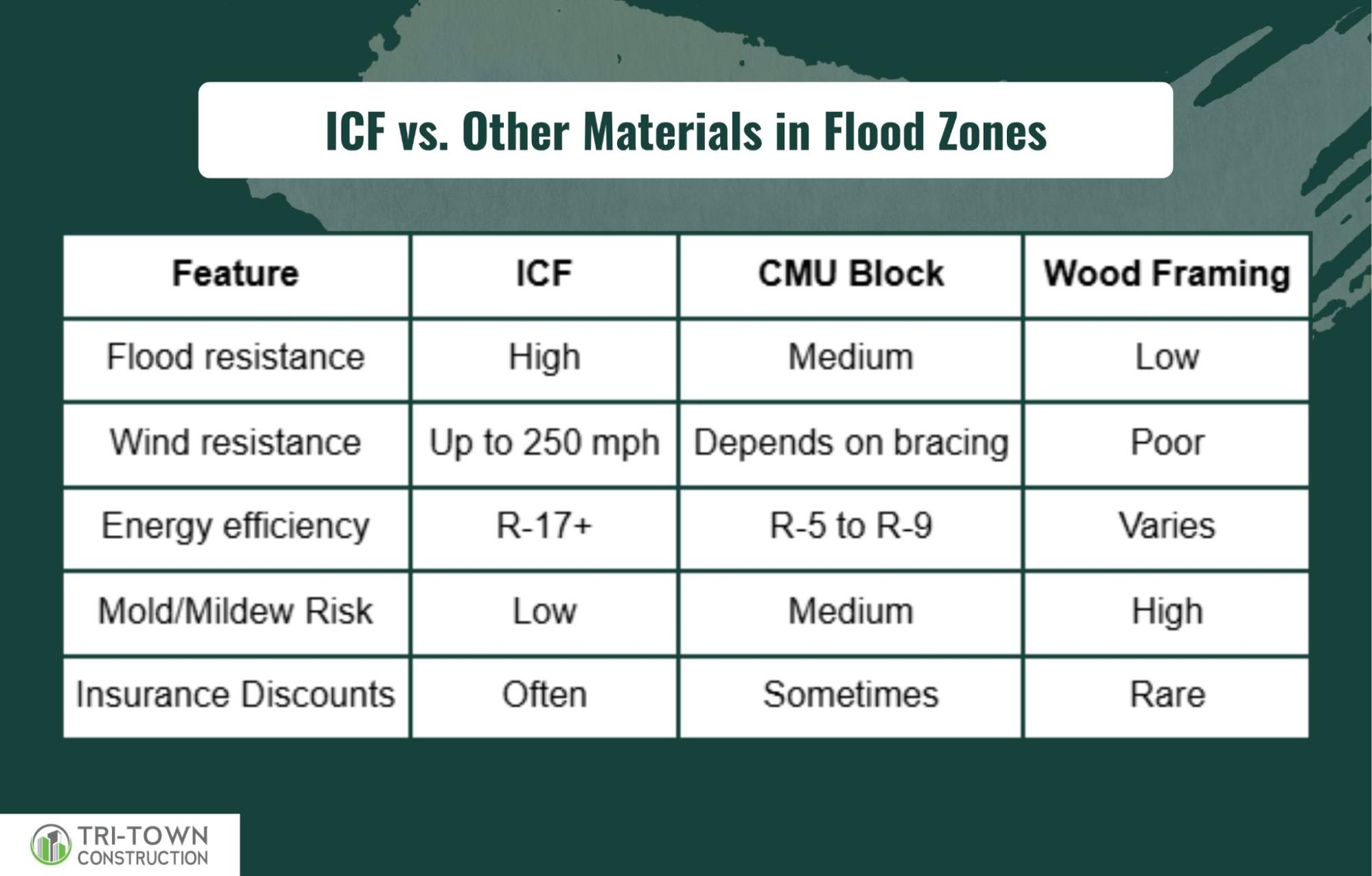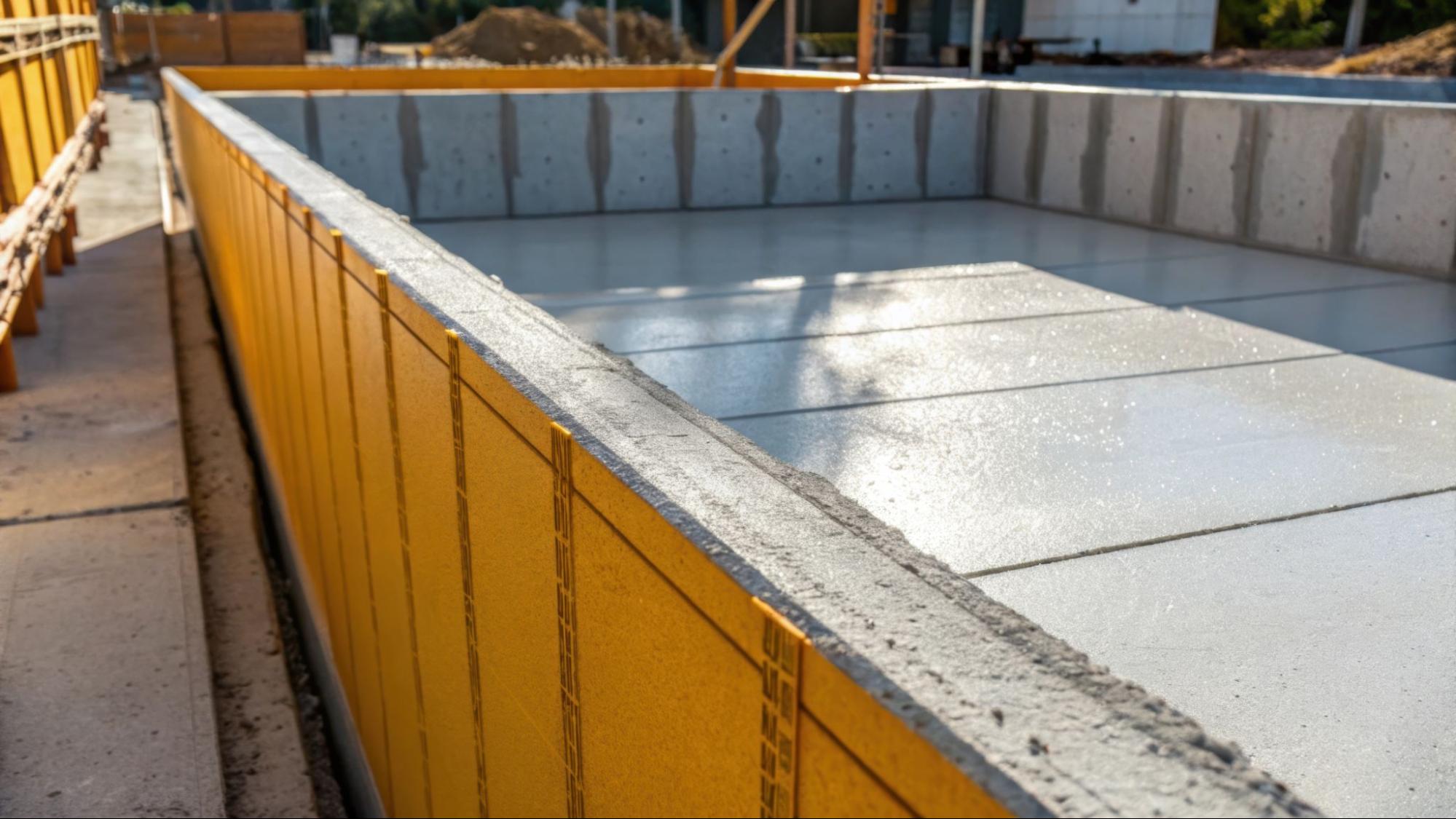Why ICF Homes Outperform Coastal Building Codes
ICF coastal homes use reinforced concrete and foam insulation to resist hurricanes up to 250 mph, floods, mold, fire, and termites. They surpass Florida’s building code standards, reduce energy costs, and provide lasting strength, safety, and comfort in storm-prone coastal regions.
Why ICF Homes Outperform Wood and Block in Coastal Construction
Insulated Concrete Forms (ICF) are reshaping coastal construction.
With reinforced concrete poured into foam blocks, they form solid walls that outperform wood or CMU and consistently exceed Florida Building Code standards. Here’s what sets ICF apart:
- Wind resistance: Withstand 200–250 mph gusts, beyond High-Velocity Hurricane Zone requirements
- Flood and mold protection: EPS foam is hydrophobic, minimizing post-flood repairs
- Energy efficiency: R-17+ insulation keeps cooling costs low in humid Florida summers
- Fire rating: Two to four hours of protection, slowing spread between dwellings
- Termite and rot-proof: Eliminates wood-based vulnerabilities common in coastal builds
- Long-term savings: Lower energy bills, reduced repairs, and insurance benefits
For homeowners, this means real peace of mind. An ICF house is quieter, safer, and more efficient, while also protecting the investment you’ve made in your property.
ICF isn’t just a material, it’s a smarter approach to coastal living.
As you’ll see ahead, choosing ICF reshapes how a home performs day-to-day and during disasters, giving it a resilience traditional methods can’t match.
What Is ICF (Insulated Concrete Forms) and How Is It Different From CMU or Wood?
ICF walls are made by stacking hollow foam blocks, typically expanded polystyrene, then reinforcing and filling them with concrete.
The foam stays in place, creating a solid, well-insulated wall that boosts strength, resists moisture, and holds consistent interior temperatures.
ICF suits a variety of builds, including elevated foundations, custom coastal homes, and modular hybrids.

ICF offers more than just a different wall system. It’s a shift in mindset , from temporary fixes to long-term resilience.
Whether you’re building from scratch or rebuilding smarter, ICF sets the stage for a home that performs better in every season.
In the next section, we’ll take a closer look at the specific benefits ICF brings to coastal homes, from energy savings to flood recovery and everything in between.
Why ICF Construction Is a Game-Changer for Coastal Homes

Living on the coast means balancing comfort with preparation for hurricanes and flooding. Rising insurance costs are also forcing homeowners to rethink how they build.
In Florida, where the Florida Building Code sets some of the nation’s toughest standards, ICF homes not only meet requirements but often go beyond them.
1. Category 5 Wind Resistance
ICF homes are engineered to stand firm against the most powerful hurricanes.
With steel-reinforced concrete cores surrounded by foam, these walls can handle wind speeds up to 250 mph.
This exceeds the FBC High-Velocity Hurricane Zone (HVHZ) requirements, which mandate structures withstand wind speeds ranging from 170 to 200+ mph in coastal areas.
The monolithic nature of ICF eliminates weak points, making it one of the most wind-resilient options available.
2. Flood and Mold Resilience
The FBC Residential Code (R322) outlines strict elevation and flood-resistant construction methods for homes in FEMA-designated flood zones.
ICF homes, especially when elevated properly or built on pilings, meet or exceed these standards.
EPS foam is hydrophobic, so it won’t absorb water, and if floodwaters enter the home, repairs are usually limited to drywall and finishes, not a full structural gut.
3. Superior Energy Efficiency
ICF walls deliver continuous insulation and air sealing in one system, reducing heating and cooling loads significantly.
In Florida’s humid climate, where the FBC requires minimum R-13 to R-19 insulation depending on wall type and orientation, ICF walls routinely surpass those values with R-17 to R-26 performance.
Homes stay cooler, use less energy, and qualify more easily for energy credits or certifications.
View this post on Instagram
4. Fire Resistance
Fire safety is a growing concern in Florida’s wildland-urban interface zones.
ICF walls have a 2 to 4-hour fire rating, complying with and often exceeding FBC Section R302, which governs fire separation between dwellings.
Because ICF contains no combustible materials, it helps slow fire spread, especially important in dense coastal communities.
5. Termite and Rot-Proof
The FBC requires termite protection (R318) for all new construction in high-risk regions, which includes much of South Florida.
ICF helps fulfill this by eliminating the use of wood in the primary wall structure. There’s nothing for termites to eat, and EPS foam doesn’t rot or decay, making ongoing treatment less intensive.
View this post on Instagram
6. Noise Reduction
ICF walls also reduce sound transmission, a major benefit in coastal zones near airports, highways, or marinas.
While not directly governed by FBC, noise performance improves quality of life and can be especially valuable in areas with mixed-use zoning or tourism-driven traffic.
7. Long-Term Cost Savings
While ICF may cost more upfront, the return on investment shows up year after year.
Energy savings, reduced maintenance, fewer storm repairs, and potentially lower insurance premiums all contribute to long-term value.
And because ICF homes are built to last, owners typically face fewer major renovations over time.
8. Quicker Construction Timeline
ICF systems streamline the construction process. Lightweight blocks assemble quickly, and once poured, the wall is complete, framing, sheathing, insulation, and structural core in one.
That’s especially useful when timing matters, such as rebuilding after a storm or during Florida’s unpredictable rainy season.
9. Better Insurance Rates
Many insurers recognize resilient construction when underwriting coastal properties.
With ICF exceeding many FBC wind and flood standards, it can help homeowners negotiate lower premiums or qualify for additional coverage, especially in designated wind-borne debris regions.
10. Safe Room Integration
FBC Section R501 and the FEMA P-361 guidelines provide best practices for storm-safe areas.
ICF’s solid structure and reinforced concrete make it a preferred material for safe rooms, whether integrated into a closet, bathroom, or core of the home.

These spaces offer families protection during shelter-in-place events without needing a separate structure.
ICF delivers strength, insulation, and safety in one system, offering lasting value and peace of mind. More than just a building material, it’s a solution built for the realities of coastal living.
Next, let’s talk honestly about some of the challenges homeowners should know before choosing ICF, and why, in most cases, they’re easier to solve than you might think.
Helpful Resource → Is ICF Construction Worth It? Pros, Cons & Cost in 2025
But What About the Downsides? Real Talk on ICF Challenges (And Their Fixes)
No building system is perfect. While ICF delivers major advantages in coastal environments, there are a few challenges worth understanding before committing.
The good news is, most of these have simple workarounds, and none outweigh the long-term benefits.
1. Cost Concerns
ICF homes typically cost more up front than wood or CMU builds.
That said, the added strength, energy savings, reduced maintenance, and better insurance positioning often offset the difference over time. For homeowners building with longevity in mind, the ROI is strong.
2. Contractor Availability
Not every builder is experienced with ICF, and that matters.
Hiring a contractor who understands the system, including how to handle pours, reinforcement, and inspections, is key.
Choosing a builder with ICF credentials and local coastal experience avoids costly mistakes and delays.

3. Plumbing and Electrical Routing
Running utilities in ICF walls is different, but not difficult.
Crews use hot knives or mechanical cutters to create channels in the foam before drywall. When coordinated early, it’s a smooth process and doesn’t slow the build.
4. Post-Build Changes
Because the walls are solid concrete, modifying them later takes more planning. Smart builders account for this by routing empty conduits or framing future access points during the build.
5. HVAC Compatibility
ICF homes are airtight and well-insulated.
This means oversized systems can cause moisture issues. Proper load calculations and ERV (Energy Recovery Ventilator) systems help maintain airflow, comfort, and indoor air quality.
6. Insurance Gaps
To fully benefit from ICF’s resilience, it’s critical to document your build for insurance. This helps underwriters understand your risk profile and can lead to better rates and more tailored coverage.
These challenges don’t diminish ICF’s value, they simply highlight where planning matters most.
With the right approach, the question becomes less about obstacles and more about whether ICF is the right fit for your coastal home.
Should You Choose ICF for Your Coastal Home?

Choosing the right construction method on the coast isn’t only about budget, it’s about peace of mind. ICF is not for everyone, but for many coastal homeowners it offers unmatched value.
- Built for long-term homeowners: ICF suits those planning to stay, who want durability, safety, and comfort for decades.
- When it may be more than you need: In lower-risk zones or for short-term living, traditional building may meet your needs more economically.
- When it’s absolutely worth it: In hurricane-prone areas like Florida, ICF proves its value. It exceeds FBC standards, resists floods and mold, and can lower insurance risks over time.
- The risk vs. reward balance: Today’s climate demands more than “just meeting code.” With ICF, you build smarter and protect your investment against both daily wear and rare disasters.
In the end, choosing ICF comes down to priorities.
For those who value resilience and long-term security, it offers a level of protection and peace of mind that traditional methods simply can’t match.
If You’re Building on the Coast, Build Smart

Coastal living comes with rewards and risks, and building with ICF ensures your home is ready for both.
Strength, safety, and efficiency are built into every wall, offering protection from hurricanes, floods, and soaring energy costs.
While Florida’s building codes set a high standard, they represent the minimum required for compliance. ICF goes further, designed for the worst-case scenarios that coastal families know too well.
For homeowners investing in their future, it’s not just a construction method, it’s peace of mind.
At Tri-Town Construction, we specialize in code-compliant, storm-resistant ICF homes that exceed expectations.
Our team has rebuilt Southwest Florida with integrity and care, delivering homes that combine resilience with comfort.
If you’re ready to explore how ICF can protect your investment and safeguard your family, Tri-Town is here to help you build smarter, stronger, and for the long run.


